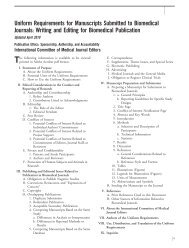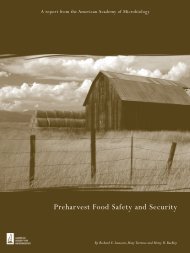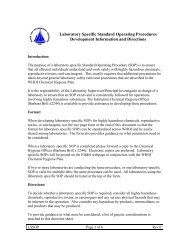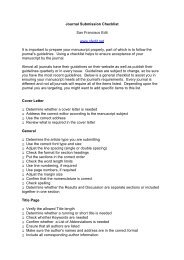Guidance for Preparing Standard Operating Procedures (SOPs)
Guidance for Preparing Standard Operating Procedures (SOPs)
Guidance for Preparing Standard Operating Procedures (SOPs)
Create successful ePaper yourself
Turn your PDF publications into a flip-book with our unique Google optimized e-Paper software.
e. Cautions (indicating activities that could result in equipment damage,<br />
degradation of sample, or possible invalidation of results; listed here and at<br />
the critical steps in the procedure),<br />
f. Interferences (describing any component of the process that may interfere<br />
with the accuracy of the final product),<br />
g. Personnel Qualifications (denoting the minimal experience the SOP<br />
follower should have to complete the task satisfactorily, and citing any<br />
applicable requirements, like certification or “inherently governmental<br />
function”),<br />
h. Equipment and Supplies (listing and specifying, where necessary,<br />
equipment, materials, reagents, chemical standards, and biological<br />
specimens),<br />
i. Procedure (identifying all pertinent steps, in order, and materials need to<br />
accomplish the procedure such as:<br />
• Instrument or Method Calibration and <strong>Standard</strong>ization<br />
• Sample Collection<br />
• Sample Handling and Preservation<br />
• Sample Preparation and Analysis (such as extraction, digestion,<br />
analysis, identification, and counting procedures)<br />
• Troubleshooting<br />
• Data Acquisition, Calculations & Data Reduction Requirements<br />
(such as listing any mathematical steps to be followed)<br />
• Computer Hardware & Software (used to store field sampling<br />
records, manipulate analytical results, and/or report data), and<br />
j. Data and Records Management (e.g., identifying any <strong>for</strong>ms to be used,<br />
reports to be written, and data and record storage in<strong>for</strong>mation).<br />
4. Quality Control and Quality Assurance Section - QC activities are designed to<br />
allow self-verification of the quality and consistency of the work. Describe here<br />
the preparation of appropriate QC procedures (self-checks, such as calibrations,<br />
recounting, reidentification) and QC material (such as blanks - rinsate, trip, field,<br />
or method; replicates; splits; spikes; and per<strong>for</strong>mance evaluation samples) that are<br />
required to demonstrate successful per<strong>for</strong>mance of the method. Specific criteria <strong>for</strong><br />
each should be included. Describe the frequency of required calibration and QC<br />
checks and discuss the rationale <strong>for</strong> decisions. Describe the limits/criteria <strong>for</strong> QC<br />
data/results and actions required when QC data exceed QC limits or appear in the<br />
warning zone. Describe the procedures <strong>for</strong> reporting QC data and results.<br />
QA/G-6 7<br />
March 2001







